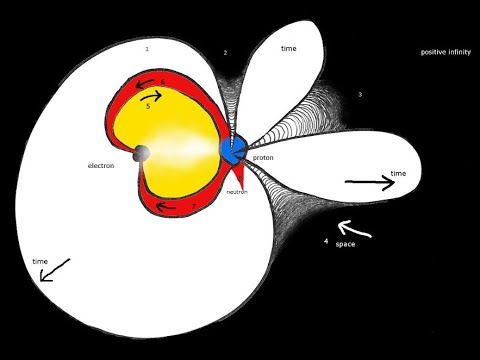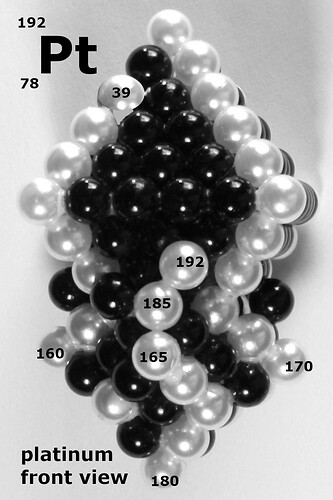Hello, I am a theoretical physicist who has detailed positions for all protons in all elements. How can Q-chem accept 3D coordinates of nuclear protons and neutrons? The nuclear structures are described in my books: “Charge distributions on the nuclei” on Amazon ($4 for the phosphorus , sulfur and chlorine data set) The hardcover book has 118 elements on 535 pages. https://www.amazon.com/gp/product/B09G4KSRH4
“Nuclear Structure from sphere stacking” is 124 pages about the nuclear structure theory (The Static Nucleus Theory of the Face-Armored Cubic Lattice).
There is a digital file with all elements’ proton and neutron coordinates, for free, called: nuclei_118_C.xyz
https://drive.google.com/file/d/1pJkovzAT4goeo_SZItBgb1D1o5Fy6ts_/view
My website gives some descriptions: https://pyramidalcube.blogspot.com/ I hope to change the open source software of Q-chem to connect nuclear protons to molecular electrons.
Carbon has 2 planes of protons to make graphite. Nitrogen has 3 protons that are prominent for a triple bond. Iron has 2 rings of protons for magnetic properties. Are nuclear proton positions useful to chemists?
Hello Alan,
The version of quantum mechanics that is implemented in Q-Chem assumes that the nuclei are point charges with no internal structure.
Hello J. Herbert,
I understand today’s version uses a point nucleus that cannot use proton coordinates. In the future, I may have a large budget to pay a chemistry consultant to provide a new solution for simulations. In particular, progress in nuclear physics indicates that a mechanistic model of chemical bonding is possible. Each proton has a durable line of flux connecting to one electron in a molecule. Bonds are the inter-twining of two lines of flux. Quantum numbers are about the wrapping of lines of flux around each other. n, l, ml, ms integers may be about wrapping and unwrapping liines of flux. The wave-function is a line of flux that has a flat shape. The velocity of a wavefunction was calulated to be 8 inches per second at 1 Kelvin.
Reverse engineering of energy levels can be attempted to justify the bond-wrapping ideas. It is a three year project for me and a planned team. Chemistry might progress from clouds of probable densities of electrons into a deterministic allocation of electrons using mechanistic models.
Thank you for your polite response.
How does this compare with the GAMESS capability that nuclear wavefunctions can also be computed, in VSCF, or with explicit treatment of nuclear orbitals by the NEO code?
The Nuclear Electron Orbital (NEO) plug-in code is developed in the group of Sharon Hammes-Schiffer at Pennsylvania State University, with programming by Simon P. Webb, Tzvetelin Iordanov, Mike Pak, and Chet Swalina. The initial release in 2006 permits HF and MP2 level treatment of nuclear wavefunctions.
Hello Jim Kress, I read about the NEO today. It used the Schrodinger Equation to make a probability of electron locations, which was common in the past. In the future work which I have begun, electrons are given deterministic positions and motions. Catalysts, like platinum and vanadium, have a line of protons that makes a hook shape. That open ring is imagined to allow an itinerant proton-loyalty current to flow through a participating molecule. The NEO method is compared by saying that nuclear structure is not knowable in the NEO, so far. I hope the Hammes-Schiffer Research Group will cooperate with my future team (Tolerable Energy) to include the lines of protons in the elements to drive the electron positions in molecules. NEO typically uses a proton for the nucleus, but they foresee using other elements’ nuclei. Carbon has two parallel planes of 3 protons, each. That is why graphite has planar crystals. Also, carbon makes flexible chains of molecules because the two proton lines do not have any other protons in the nucleus to hinder the directional changes of the wavefunctions.
https://www.hammes-schiffer-group.org/research-overview/neom/
GAMESS comparison to Deterministic Nuclear Charge Allocations using The Static Nucleus Theory of the Face-Armored Cubic Lattice (DNCA)
I read about GAMESS today. The self-consistent field method emphasizes the Hamiltonian energy-centric ideas. The square root of energy is flux. My ideas emphasize flux (meter squared per second = Ampere = Weber) to use a finer level of descriptions of wavefunctions. As is consistent with standard quantum wavefunctions, energy is the wavefunction squared. Magnetic lines of flux are large versions of atomic wavefunctions. Flux has two space-like dimensions and one time-like dimension going the other way, between a proton and an electron. It is analogous to gravity, where time goes out from a proton and space goes in. Ab initio vibrational self-consistent field theory is an energy-centric idea, in comparison with my flux-centric ideas.
The GAMESS description writes that, “Nuclear gradients are available, for automatic geometry optimization, transition state searches, or reaction path following.” And, “Nuclear wavefunctions can also be computed, in VSCF, or with explicit treatment of nuclear orbitals by the NEO code.” The software for GAMESS seems to be useful for possible cooperation to implement the nuclear structures on a computational chemistry program. I am not a chemist, so I cannot do this alone. Now that all elements have coordinates for all protons and neutrons, a finer level of detailing can be used than that allowed by today’s software. Many acronyms in the documentation are not familiar to me.
https://www.msg.chem.iastate.edu/gamess/
In conclusion, it will be a lot of work to go from probabilistic quantum chemistry to mechanistic, deterministic chemistry. The Pauli Exclusion Principle is being extended to other types of exclusions of the flat wavefunction ribbons, so they do not penetrate each other without an Ohmic Cycle. Alan Folmsbee
NEO is available in Q-Chem, you are welcome to play around with it but I do not think it does what you want. Allows nuclear (usually hydrogen) wave function to delocalize but even for heavier elements it does not attempt to resolve it into protons and neutrons.

